Chemistry > QUESTIONS & ANSWERS > University of North Texas - CHEM 1420TB: Chapter 15—Complex Ion and Precipitation Equilibria. All (All)
University of North Texas - CHEM 1420TB: Chapter 15—Complex Ion and Precipitation Equilibria. All Questions and Answers
Document Content and Description Below
MULTIPLE CHOICE 1. Which of the following equations represents the formation constant of Ti(NH3)63+? 2. The formation constant for Zn(NH3)42+ is 3.6 108. What is the ratio of Zn(NH3)42... + to Zn2+ in 0.010 M NH3? 3. The formation constant for Ag(CN)2(aq) is 2 1020. At what cyanide ion concentration is [Ag+] = [ Ag(CN)2]? 4. Ksp stands for 5. What is the chemical equation that describes the dissolution of calcium iodate in water? 6. What is the chemical equation that describes the dissolution of nickel(II) hydroxide in water? 7. What is the chemical equation that describes the dissolution of silver oxalate, Ag2(C2O4), in water? 8. Which of the following equations is the solubility product of Cu(II) hydroxide, Cu(OH)2? a. 9. What is the equilibrium constant expression for the dissolution of solid lead oxalate, PbC2O4, in water? 10. What is the equilibrium constant expression for the dissolution of solid calcium fluoride in water? 11. Consider the equilibrium of PbCl2(s) in water. PbCl2(s) Pb2+(aq) + 2Cl(aq) What is the effect of adding NaCl(aq) to the equilibrium solution? 12. Consider the equilibrium of Ca(OH)2(s) in water. Ca(OH)2(s) Ca2+(aq) + 2OH(aq) What is the effect of raising the pH of the solution? 13. Consider the equilibrium of lead sulfide, PbS, in water. PbS(s) Pb2+(aq) + S2(aq) What is the effect of adding PbS(s) to the solution? 14. Consider the equilibrium of magnesium fluoride, MgF2(s), in water. MgF2(s) Mg2+(aq) + 2F(aq) What is the effect of adding perchloric acid (i.e. decreasing the pH of solution)? 15. The Ksp of barium chromate is 1.2 1010. What is the concentration of Ba2+ in equilibrium with BaCrO4(s) if [CrO42] = 4.3 103 M? 16. The Ksp of calcium iodate is 7.1 107. What is the concentration of Ca2+ in equilibrium with Ca(IO3)2(s) if [IO3] = 3.3 102 M? 17. The Ksp of aluminum hydroxide, Al(OH)3, is 2 1031. What pH is required to limit the Al3+ concentration to less than or equal to 1 1010 M? 18. The Ksp of calcium phosphate is 1 1033. What is the concentration of Ca2+ in equilibrium with Ca3(PO4)2(s) if [PO43] = 1 105 M? 19. The Ksp of Fe(OH)3(s) is 3 1039. What concentration of Fe3+ can exist in solution at pH 3.0? 20. The Ksp of BaSO4 is 1.1 10–10 at 25C. What mass of BaSO4 (molar mass = 233.4 g/mol) will dissolve in 1.0 L of water at 25C? 21. For AgCl, Ksp = 1.8 1010. What will occur if 250 mL of 1.5 103 M NaCl is mixed with 250 mL of 2.0 107 M AgNO3? 22. For PbCl2, Ksp = 1.7 105. What will occur if 250 mL of 0.12 M Pb(NO3)2 is mixed with 250 mL of 0.070 M NaCl? 23. For Ca(OH)2, Ksp = 4.0 106. What will occur if 1.0 L of 0.100 M Ca(NO3)2 is prepared in a solution that is buffered at pH 12.50? 24. For Mg(OH)2, Ksp = 6 1012. What will occur if 1.0 L of 0.010 M Mg(NO3)2 is prepared at pH 10.00? 25. What is the water solubility of AgI (Ksp = 1 1016, MM = 234.8 g/mol) in moles per liter? 26. What is the water solubility of PbI2 (Ksp = 8.4 109, MM = 461 g/mol) in moles per liter? 27. What is the water solubility of Hg2Br2 (Ksp = 6 1023) in moles per liter? 28. What is the water solubility of AgCl (Ksp = 1.8 1010, MM = 143.4 g/mol) in grams per liter? 29. The Ksp of BaSO4 is 1.1 10–10 at 25C. What mass of BaSO4 (molar mass = 233.4 g/mol) will dissolve in 1.0 L of water at 25C? 30. What volume of water is needed to completely dissolve 100 g of AgBr (Ksp = 5 1013, 187.8 g/mol)? 31. What volume of water is needed to completely dissolve 1.0 g of Ag2CrO4 (Ksp = 8.0 1012, MM = 331.8 g/mol)? 32. The Ksp of Ca(OH)2 is 5.5 10–5 at 25C. What is the concentration of OH–(aq) in a saturated solution of Ca(OH)2(aq)? 33. A saturated solution of lead(II) sulfate can be prepared by diluting 0.0101 g of PbSO4 to 250 mL. What is the Ksp of lead(II) sulfate? 34. At pH 10.0, only 0.019 g of MgCl2 will dissolve per 1 L of solution. What is the Ksp of magnesium hydroxide, Mg(OH)2? 35. The solubility of BaCrO4(s) in water is 3.7 milligrams in 1.0 L at 25C. What is the value of Ksp for BaCrO4? 36. What is the concentration of Ag+ in a saturated solution of Ag2CrO4 if Ksp = 1 1012? 37. What is the concentration of Hg22+ in a saturated solution of Hg2Cl2 if Ksp = 1 1018? 38. What is the water solubility of AgCl (Ksp = 1.8 1010) in 0.25 M NaCl? 39. What is the water solubility of BaCO3 (Ksp = 2.6 109) in a solution containing 0.20 M CO32-(aq)? 40. What is the water solubility of PbI2 (Ksp = 8.4 109) in 0.15 M KI? 41. What is the water solubility of BaF2(s) in 0.033 M KF(aq) at 25C? The Ksp of BaF2 is 1.8 10–7 at 25C. 42. What is the molar solubility of Fe(OH)3(s) in a solution that is buffered at pH 2.50 at 25C? The Ksp of Fe(OH)3 is 6.3 10–38 at 25C. 43. An aqueous solution contains 0.010 M Br– and 0.010 M I–. If Ag+ is added until AgBr(s) just begins to precipitate, what are the concentrations of Ag+ and I–? (Ksp of AgBr = 5.4 10–13, Ksp of AgI = 8.5 10–17) 44. A solution contains 0.10 M Ca2+ and 0.10 M Mg2+. The pH of the solution is raised without changing the volume of the solution. What percentage of Mg2+ remains in solution when Ca(OH)2(s) first begins to precipitate? (Ksp of Ca(OH)2 = 4.0 106 and Ksp of Mg(OH)2 = 7.1 1012) 45. What is the net ionic equation for the reaction of iron(III) hydroxide with a strong acid? 46. What is the net ionic equation for the reaction of Ca3(PO4)2 with a strong acid? 47. Determine the equilibrium constant, K, for the following reaction, Mg(OH)2(s) + 2H+(aq) Mg2+(aq) + 2H2O(l) given the Ksp of Mg(OH)2 is 6 1012 and Kw is 1.0 1014. 48. Determine the equilibrium constant, K, for the following reaction, Ca(OH)2(s) + 2H+(aq) Ca2+(aq) + 2H2O(l) given the Ksp of Ca(OH)2 is 4.0 106 and Kw is 1.0 10-14. 49. What is the net ionic equation for the reaction of KCl with a strong base? 50. What is the net ionic equation for the reaction of ZnS with a strong acid? 51. What is the net ionic equation for the reaction of an aqueous solution of AgNO3 and NH3? 52. Given the following reactions, AgBr(s) Ag+(aq) + Br–(aq) Ksp = 5.4 10–13 Ag+(aq) + 2 CN–(aq) Ag(CN)2–(aq) Kf = 1.2 1021 determine the equilibrium constant for the reaction below. AgBr(s) + 2 CN–(aq) Ag(CN)2–(aq) + Br–(aq) 53. Consider the reaction Cu(OH)2(s) + 4NH3(aq) Cu(NH3)42+(aq) + 2OH(aq) K = 4 107 If the Kf for Cu(NH3)42+ is 1 1012, what is the value of Ksp for Cu(OH)2? 54. A solution containing an unknown metal ion is analyzed by qualitative analysis. Addition of chloride has no effect on the solution. Addition of H2S at pH 0.5 results in a precipitate. What group of cations is present? 55. Which of the following metals will precipitate as chloride salts: Ag+, Pb2+, Ca2+, K+, and Cu2+? 56. In the qualitative analysis scheme, Mg2+ is a group IV cation. What anion is used to precipitate Mg2+? 57. Which of the boxes below represents solid MX2 in equilibrium with M2+ (squares) and X (circles)? 58. A soluble ionic species, SX, is dissolved in water. An excess of slightly soluble solid, MX, is added to the solution. Which of the boxes below represents MX in equilibrium with M+ (squares) and X (circles) in the presence of SX? 59. A solution containing an unknown metal ion is analyzed by qualitative analysis. Addition of chloride has no effect on the solution. Addition of H2S at pH 0.5 results in no precipitate. Addition of H2S at pH 9.0 results in no precipitate. What group(s) of cations may be present? 60. The addition of an anion to dissolve one precipitate from a mixture of precipitates is known as _____ . [Show More]
Last updated: 1 year ago
Preview 1 out of 13 pages
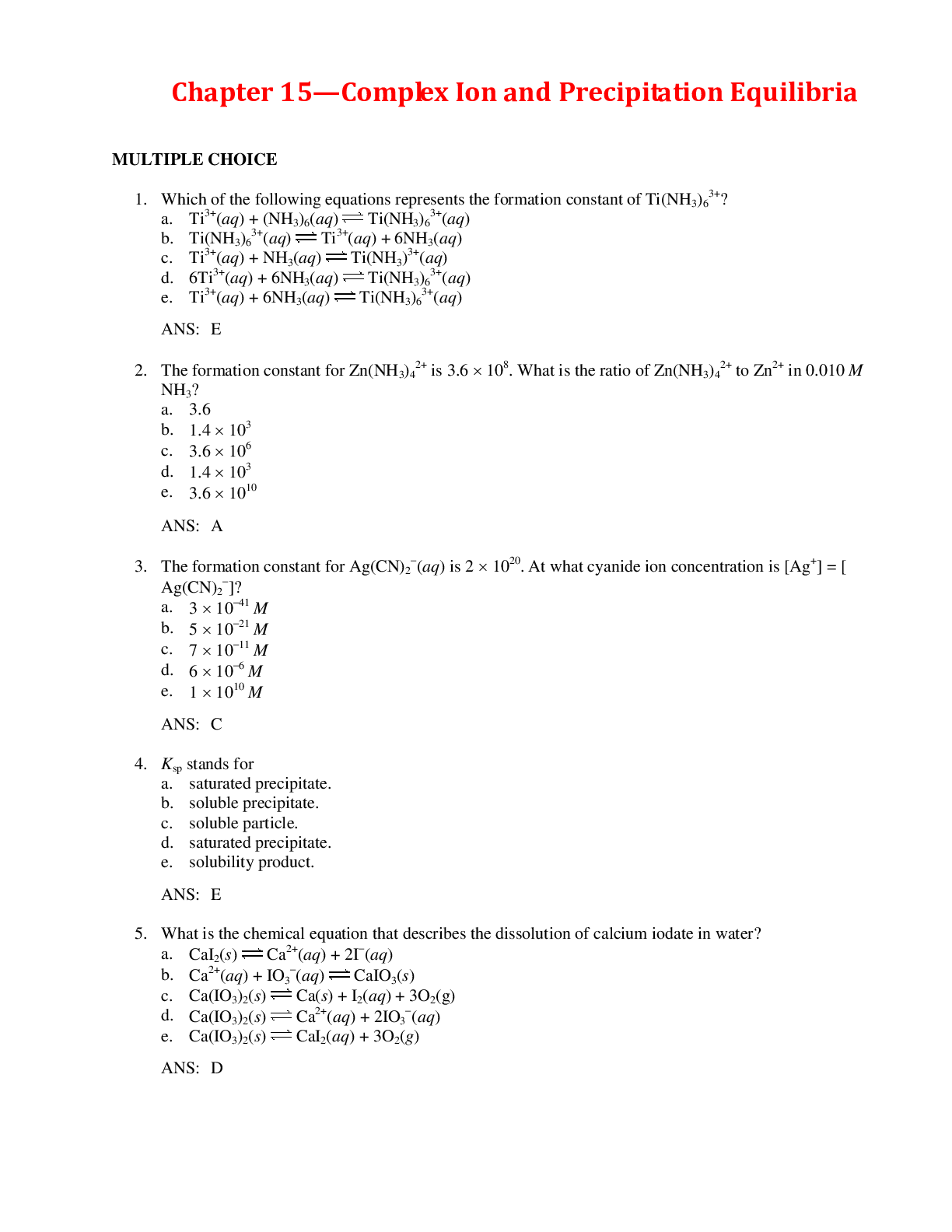
Reviews( 0 )
Document information
Connected school, study & course
About the document
Uploaded On
May 15, 2020
Number of pages
13
Written in
Additional information
This document has been written for:
Uploaded
May 15, 2020
Downloads
0
Views
141


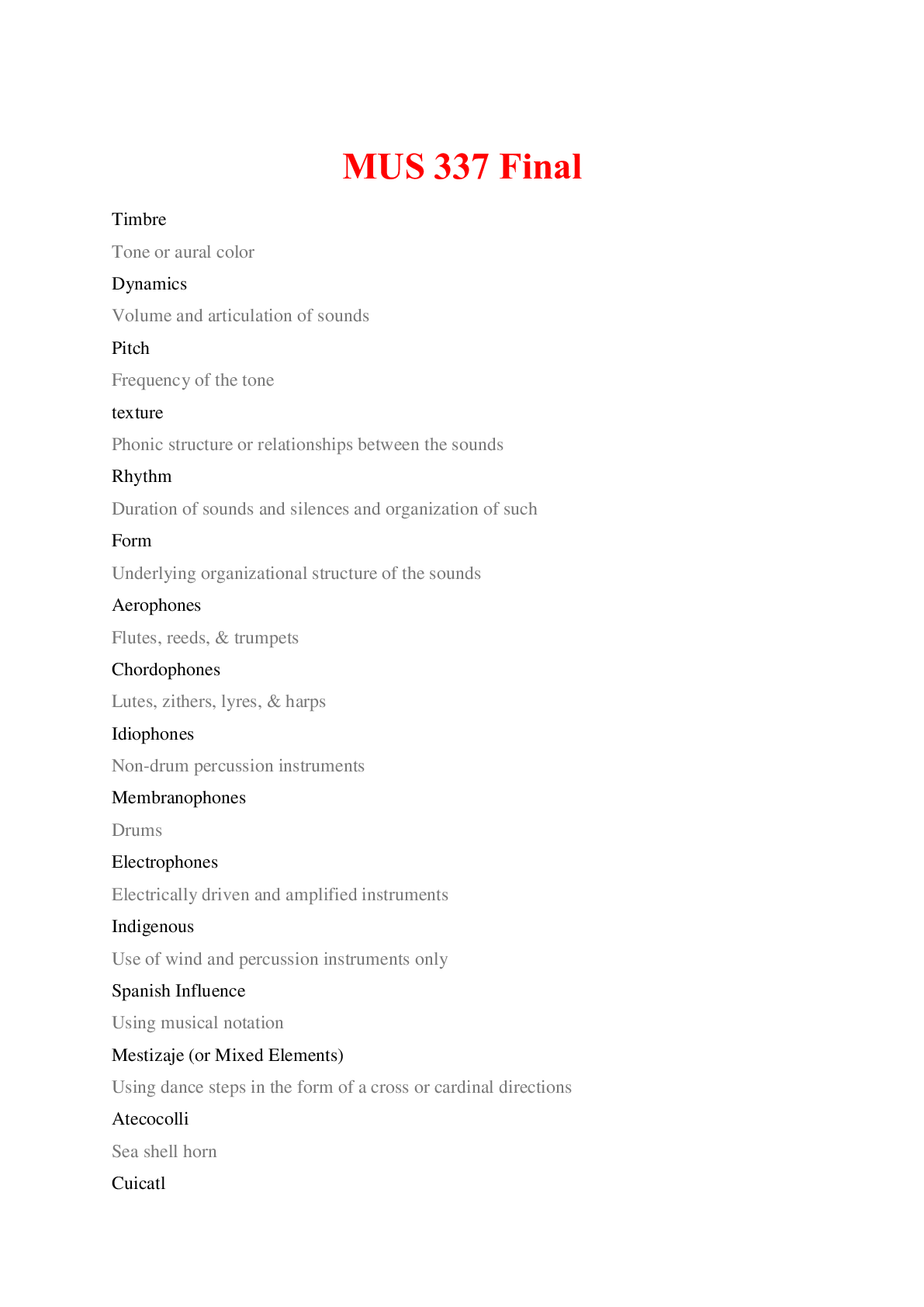







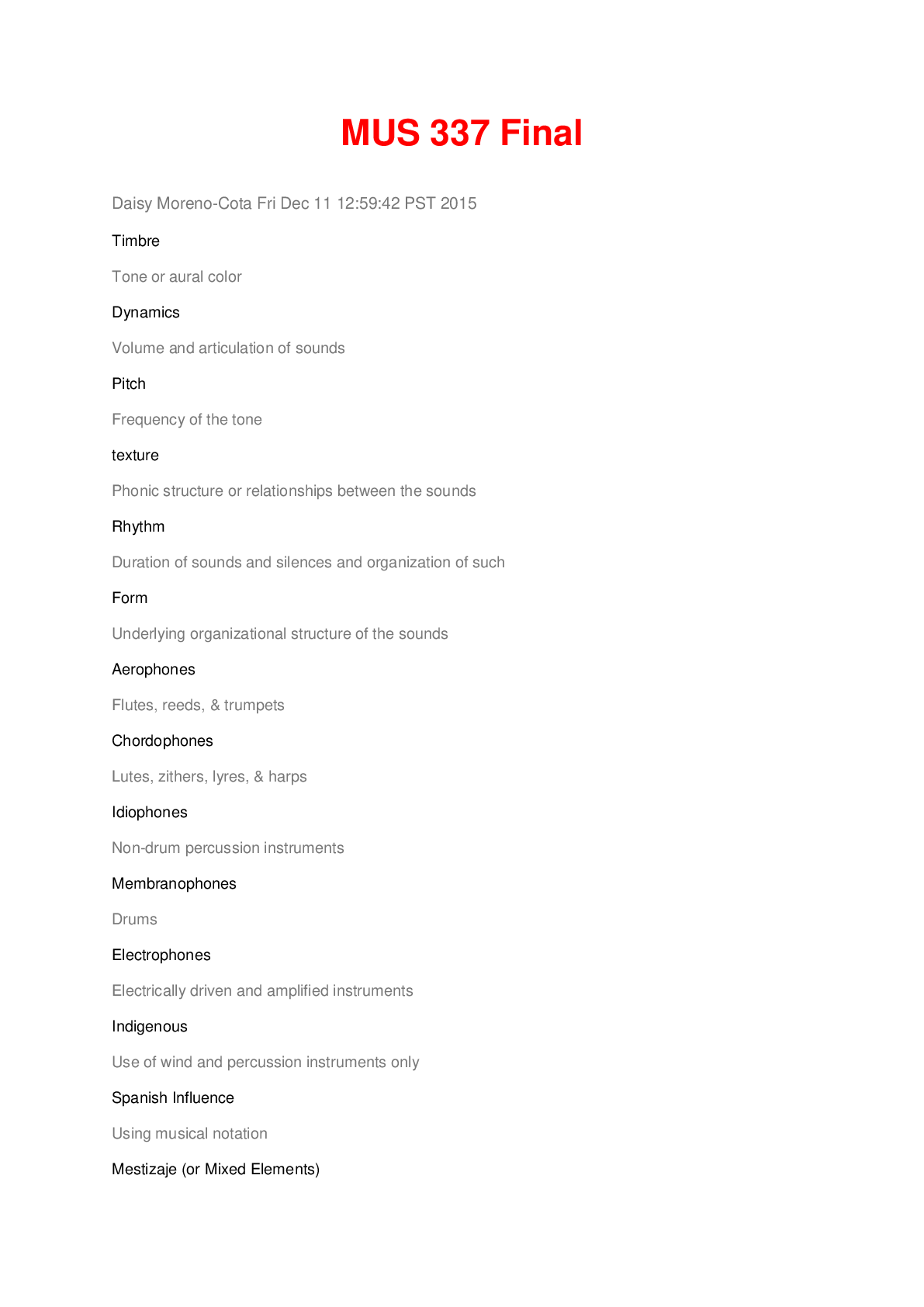




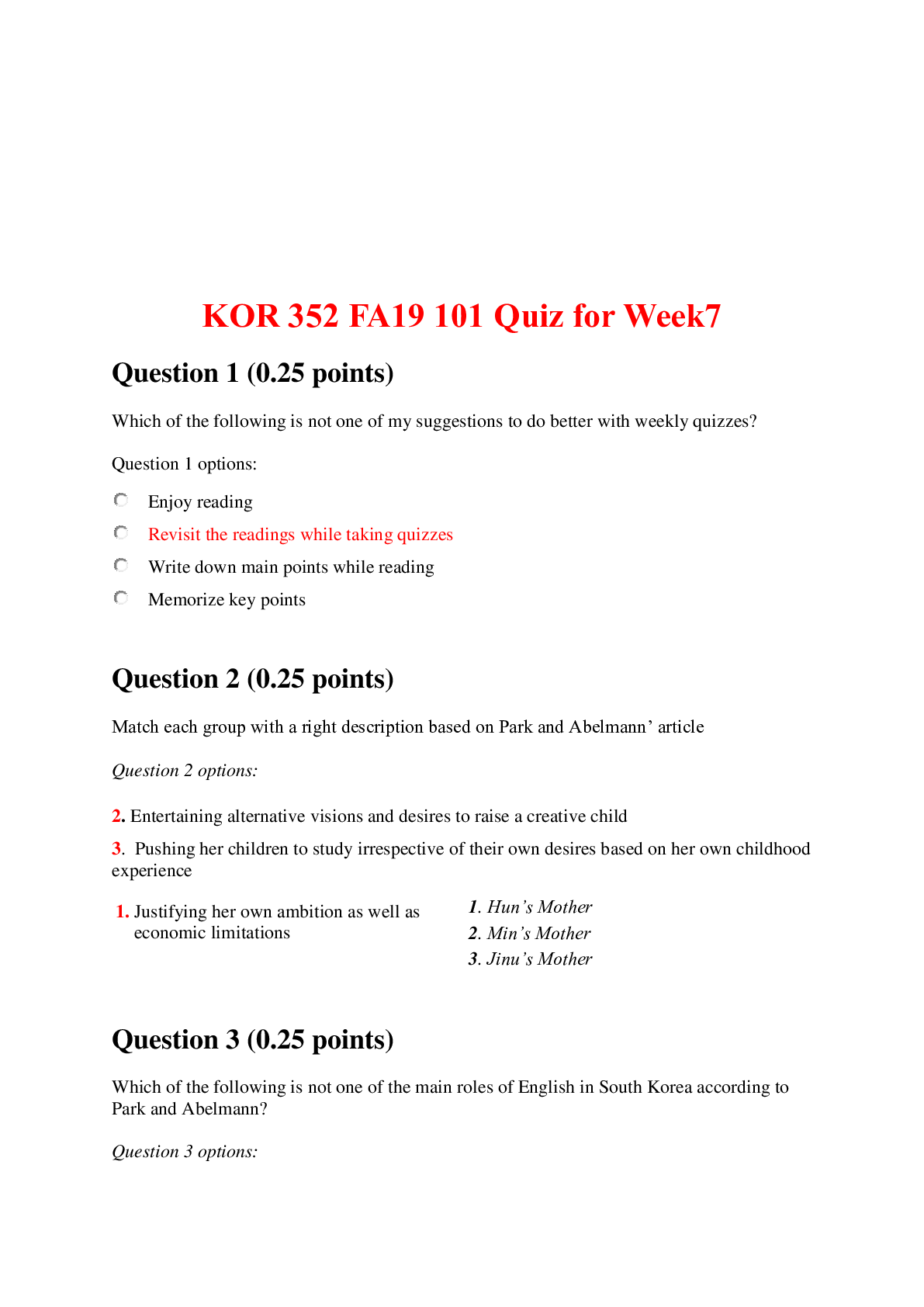


.png)
.png)
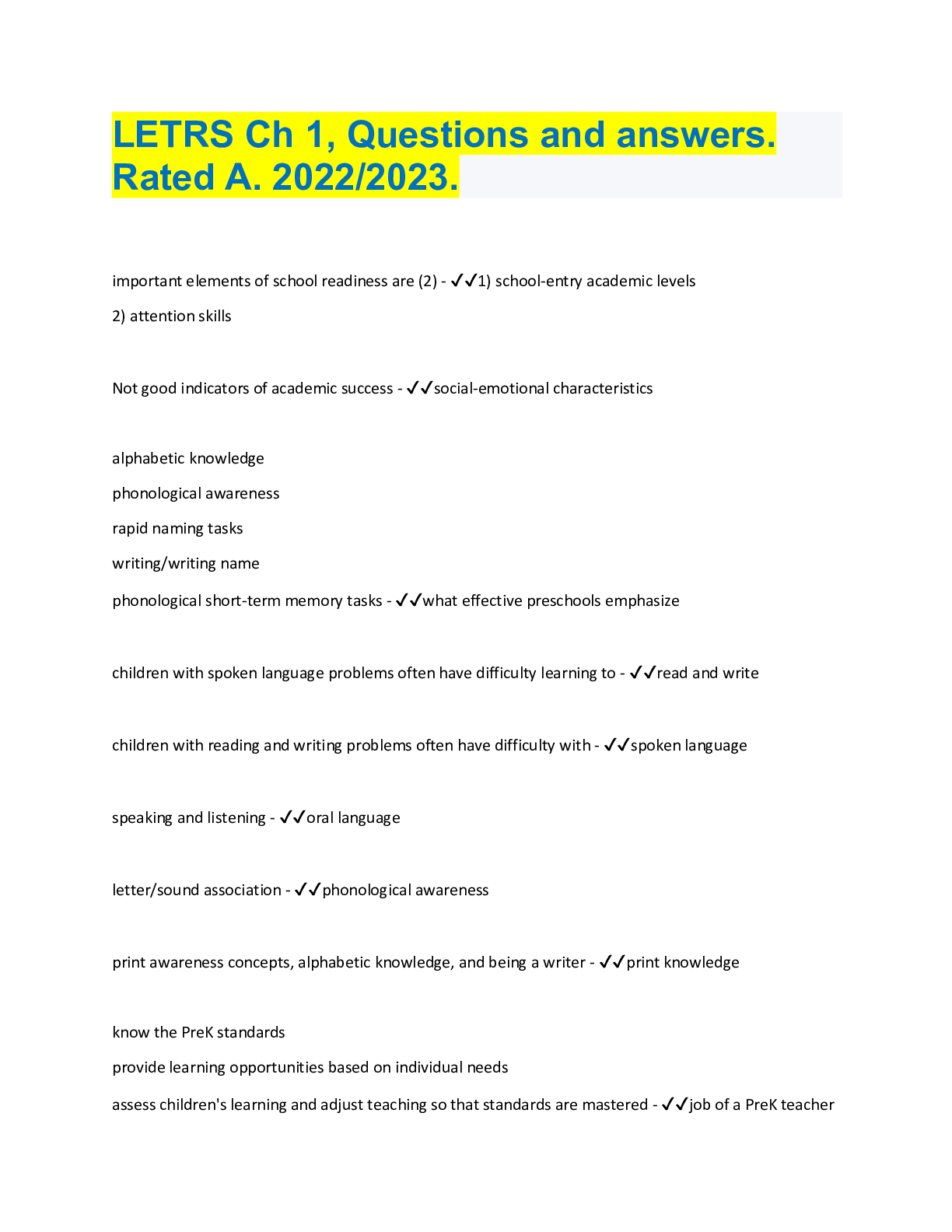
.png)
.png)




.png)
.png)
.png)
.png)
.png)






